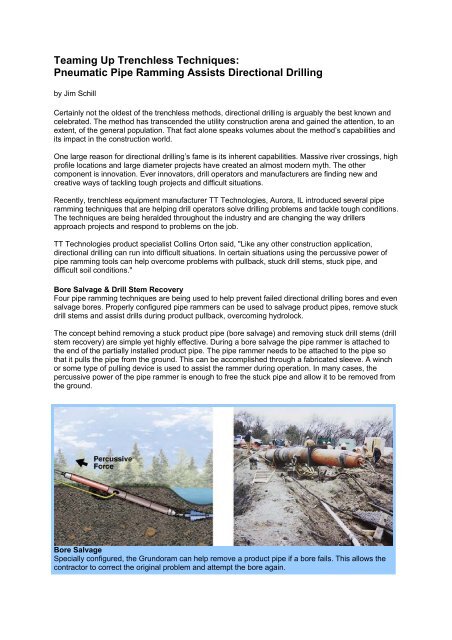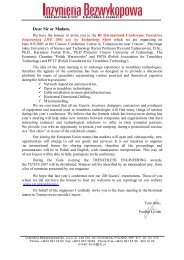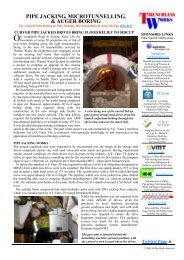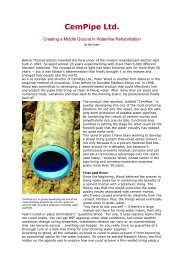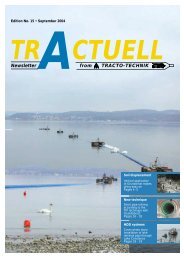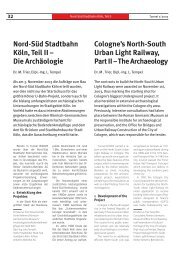Pneumatic Pipe Ramming Assists Directional Drilling - nodig ...
Pneumatic Pipe Ramming Assists Directional Drilling - nodig ...
Pneumatic Pipe Ramming Assists Directional Drilling - nodig ...
You also want an ePaper? Increase the reach of your titles
YUMPU automatically turns print PDFs into web optimized ePapers that Google loves.
Teaming Up Trenchless Techniques:<br />
<strong>Pneumatic</strong> <strong>Pipe</strong> <strong>Ramming</strong> <strong>Assists</strong> <strong>Directional</strong> <strong>Drilling</strong><br />
by Jim Schill<br />
Certainly not the oldest of the trenchless methods, directional drilling is arguably the best known and<br />
celebrated. The method has transcended the utility construction arena and gained the attention, to an<br />
extent, of the general population. That fact alone speaks volumes about the method’s capabilities and<br />
its impact in the construction world.<br />
One large reason for directional drilling’s fame is its inherent capabilities. Massive river crossings, high<br />
profile locations and large diameter projects have created an almost modern myth. The other<br />
component is innovation. Ever innovators, drill operators and manufacturers are finding new and<br />
creative ways of tackling tough projects and difficult situations.<br />
Recently, trenchless equipment manufacturer TT Technologies, Aurora, IL introduced several pipe<br />
ramming techniques that are helping drill operators solve drilling problems and tackle tough conditions.<br />
The techniques are being heralded throughout the industry and are changing the way drillers<br />
approach projects and respond to problems on the job.<br />
TT Technologies product specialist Collins Orton said, "Like any other construction application,<br />
directional drilling can run into difficult situations. In certain situations using the percussive power of<br />
pipe ramming tools can help overcome problems with pullback, stuck drill stems, stuck pipe, and<br />
difficult soil conditions."<br />
Bore Salvage & Drill Stem Recovery<br />
Four pipe ramming techniques are being used to help prevent failed directional drilling bores and even<br />
salvage bores. Properly configured pipe rammers can be used to salvage product pipes, remove stuck<br />
drill stems and assist drills during product pullback, overcoming hydrolock.<br />
The concept behind removing a stuck product pipe (bore salvage) and removing stuck drill stems (drill<br />
stem recovery) are simple yet highly effective. During a bore salvage the pipe rammer is attached to<br />
the end of the partially installed product pipe. The pipe rammer needs to be attached to the pipe so<br />
that it pulls the pipe from the ground. This can be accomplished through a fabricated sleeve. A winch<br />
or some type of pulling device is used to assist the rammer during operation. In many cases, the<br />
percussive power of the pipe rammer is enough to free the stuck pipe and allow it to be removed from<br />
the ground.<br />
Bore Salvage<br />
Specially configured, the Grundoram can help remove a product pipe if a bore fails. This allows the<br />
contractor to correct the original problem and attempt the bore again.
During a drill stem recovery the principal is the same, however, there are two possible tool<br />
configurations. Depending on the situation, contractors may opt to remove the drill stem from the<br />
ground or, if the stem is still attached to the drill rig, they may choose to push on the stem while the<br />
drill rig pulls back.<br />
Orton said, "In these situations typically the contractor has run out of options and is looking to salvage<br />
the project. As most know, drill stems can be very expensive, so leaving them stuck in the ground is<br />
not desired. Product pipe, obviously, is very expensive as well. The last thing anyone wants to do is<br />
leave it in the ground as an incomplete bore. Plus, by removing it, the contractor now has the<br />
opportunity correct the original problem and bore again."<br />
Drill Stem Recovery<br />
The percussive force of the Grundoram can free stuck drill stems by either removing them from the<br />
ground or pushing on them while the drill rig pulls.<br />
Pull Back Assist<br />
The pullback assist method works directly on getting the product pipe installed. <strong>Drilling</strong> underwater or<br />
in loose flowing soil conditions a condition known as hydrolock can occur. Orton said, "Hydrolock is a<br />
situation were the external pressure being put on the product pipe from ground water pressure, drilling<br />
fluid pressure and/or soil conditions exceeds the drill rig’s pullback capability or the product pipe’s<br />
tensile strength. The percussive action of a pipe rammer in this situation can help free the immobilized<br />
pipe."<br />
The pullback assist technique has been successfully used on steel pipe, as well as HDPE. The<br />
technique can be used as a safety measure in anticipation of hydrolock problems or after the pipe has<br />
become immobilized (See Diagram C). According to Orton, time is a key factor with any of these<br />
methods. He said, "Reaction time is always important. Not hesitating to mobilize needed equipment<br />
and expertise in these situations can really make the difference between success and failure. Success<br />
rates improve dramatically depending upon how quickly problems are responded to. In fact, a number<br />
of drilling contractors are starting bring ramming equipment to directional drilling sites as a form of<br />
insurance in case problems develop."
Pullback Assist<br />
During pullback assist the percussive action of the Grundoram keeps product pipes moving during<br />
pullback, helping overcome hydrolock and preventing high levels of pullback stress.<br />
Conductor Barrel<br />
The Conductor Barrel process differs slightly from the other three methods in the sense that it deals<br />
with the actual drilling aspect of the project rather than pullback or recovery. The concept behind the<br />
Conductor Barrel is creating a clear pathway through poor soil conditions so that drilling can begin in<br />
more preferable soil conditions. The success of a drilling operation can often be determined right at<br />
the start. If drilling does not begin in soil that is conducive to drilling, the success of the entire project<br />
can be put in jeopardy. Loose, unsupported soils are prime candidates for the Conductor Barrel<br />
method.<br />
During the Conductor Barrel process, casings are rammed into the ground, at a predetermined angle,<br />
until desirable soil conditions are met. The spoil is removed from the casing with an auger or core<br />
barrel. <strong>Drilling</strong> proceeds within the casing in the desirable soil conditions. In addition to assisting<br />
drilling operations at the start, the conductor can also serve as a friction-free section during pullback<br />
(See Diagram D).<br />
Orton said, "The conductor barrel technique is often used for river or water crossings. The length of<br />
the conductor barrel is determined by soil conditions, the angle of the bore and the depth of the<br />
crossing below the waterway. Regardless, it is imperative for drilling to begin in suitable soil<br />
conditions. In addition, the conductor barrel can prevent situations in unstable soils where drilling fluids<br />
under pressure force their way into waterways or wetlands, acting in a similar fashion to containment<br />
cells."<br />
<strong>Drilling</strong> contractors throughout North America have successfully employed all four directional assist<br />
techniques.
Conductor Barrel<br />
Conductor Barrel casings create a clear path through difficult soil conditions allowing drill operations<br />
to begin in more desirable soil conditions. Once the casing is rammed to the desired depth the spoil<br />
is cleaned out and drill takes place within the casing.


